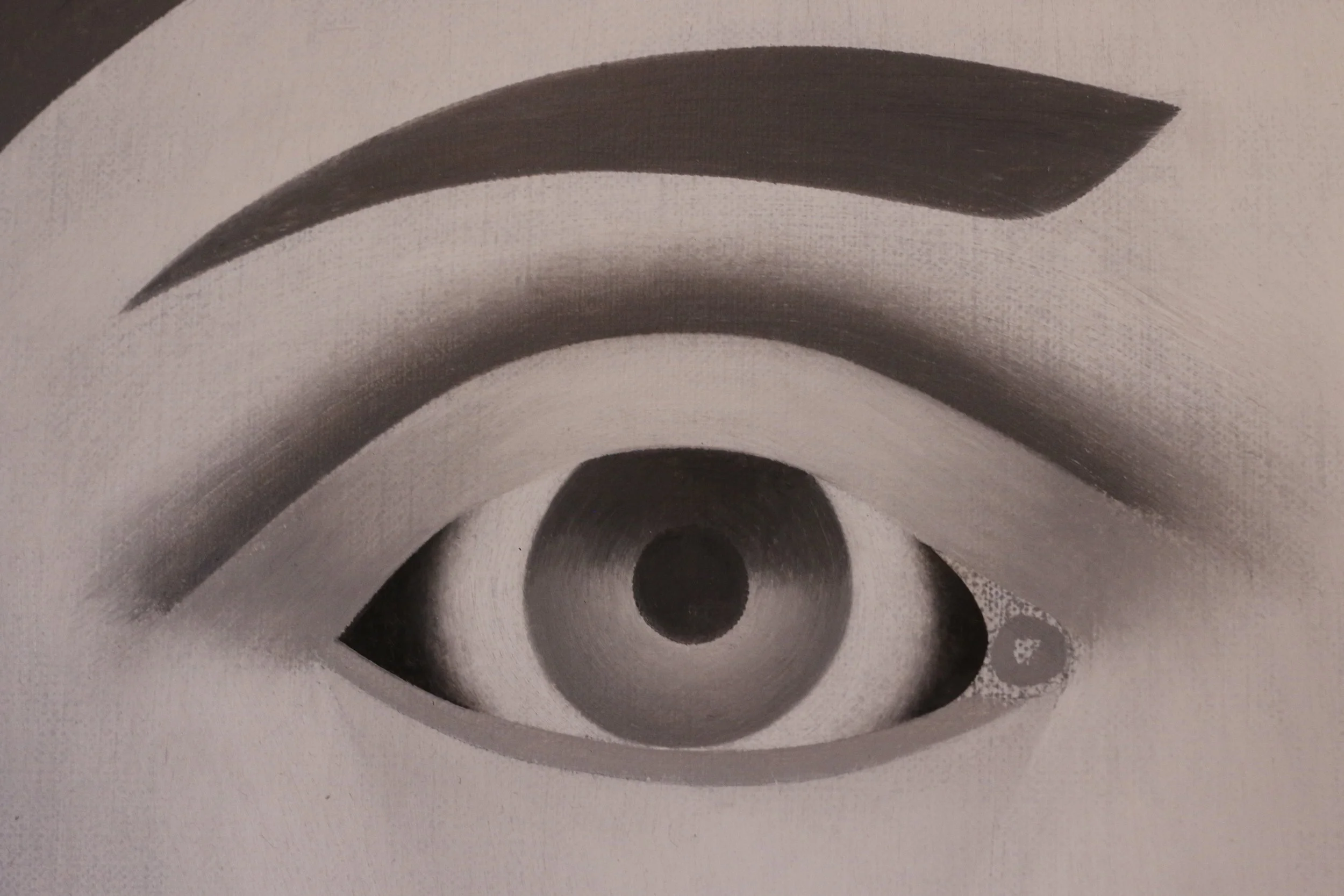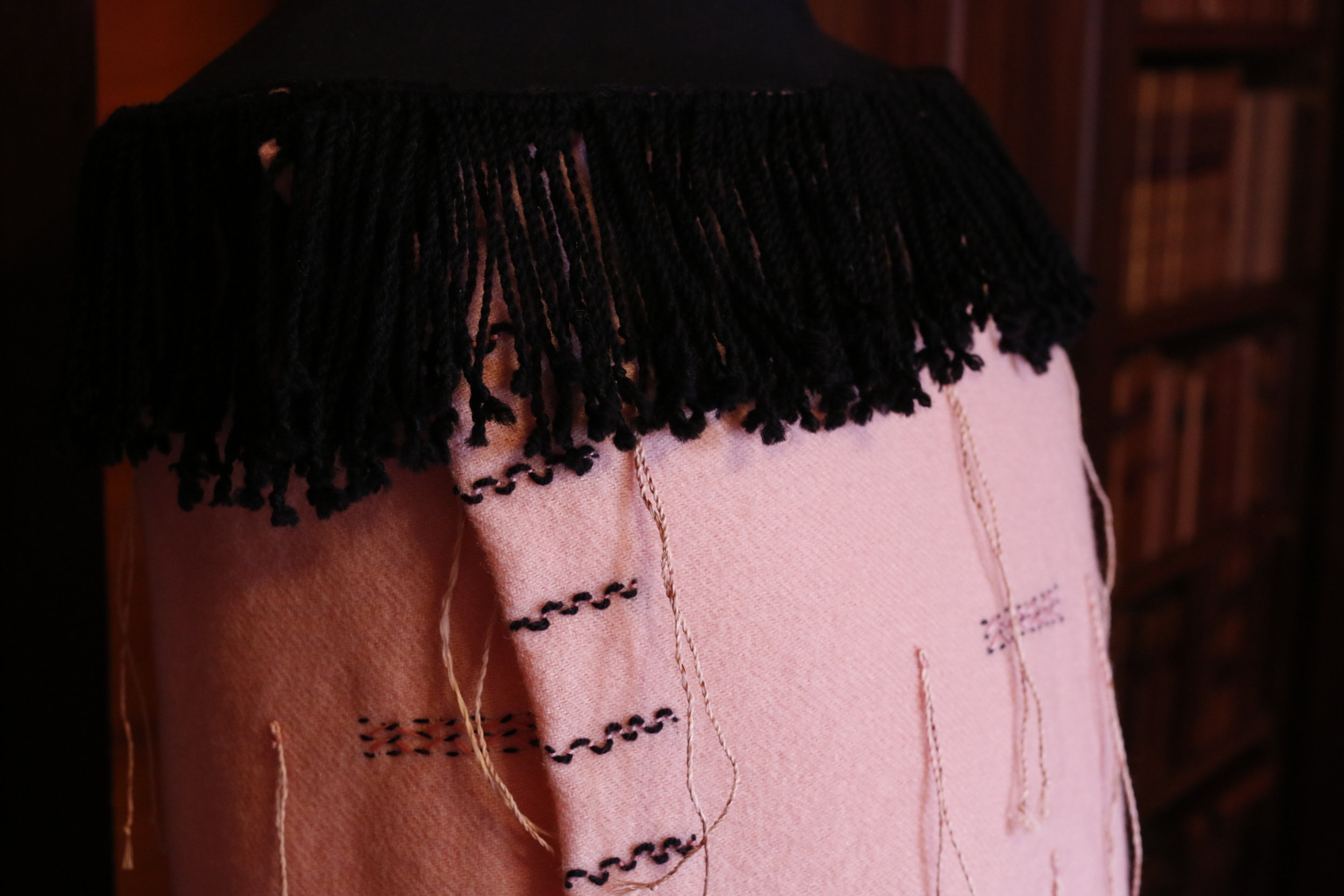Interpreting a time and place
Gavin Hurely, Whose that Girl, 2018, installation detail. Courtesy of Tauranga Art Gallery. Andrew Warner Photography.
It’s a crisp drizzly morning when I arrive at the oldest European building in Tauranga.
Originally a Georgian mission house, it is now known as The Elms Te Papa Tauranga. Greeted by one of its dedicated volunteer guides, I am welcomed through the back door and into the foyer-like hallway of naked kauri walls. Over the next two hours, I’m taken back to the 19th century when The Elms was built. Each room is set up in a traditional museum diorama format to tell the story of the family who lived there between 1838 and 1991, beginning and centred on Archdeacon Alfred Brown. My guide describes a pious, well-read man who travelled to Aotearoa New Zealand, accompanied by his wife Charlotte and around 2000 books. Charlotte had a passion for music and brought one of the earliest pianos to our islands. When they first arrived at Te Papa (Tauranga), they lived in a raupō cottage with their two small children. She germinated roses, and as the story goes, they grew through the walls of the Browns’ bedroom.
This romantic tale transports me to Jane Campion’s bittersweet film The Piano (1993) and I catch myself. So often, we look at the past with either the rose-tinted glasses of nostalgia or the unearned confidence of hindsight. Life must have been extraordinarily difficult, as suggested by the nine long years it took to complete the wooden buildings on the property. The mission developed during a turbulent time in our history, first with intertribal warfare followed by the New Zealand Wars. Local iwi Ngāi Te Rangi invited the Church Missionary Society to their rohe – a growing tikanga during that time – so as to access a new system of matauranga that had arrived on their shores. An earnest and hard-working man, Brown learned te reo Māori; travelled monthly around the Bay of Plenty and delivered sermons in the mission’s chapel. He was also reportedly caught between his adopted Māori community, the Church Missionary Society and the Crown. It’s clear countless narratives are bound up in this place. However, like so many historic homes and museums around the world, limited resources mean interpretation can be complicated to unpack for a contemporary, multicultural audience.
John Roy, Forgotten Things, 2018, installation detail. Courtesy Tauranga Art Gallery. Andrew Warner Photography.
Karl Chitham, director of the Tauranga Art Gallery and Andrew Gregg, manager of The Elms, both took on their roles around three years ago. Both also have a shared interest in creating new, accessible pathways to their institutions and saw an opportunity for locals to engage with their heritage in a unique way, in this city without a museum. Chitham’s proposal was to invite a group of artists to create site-specific installations, which mingled their work with collection items displayed in the house and its standalone library, as well as those usually kept in storage to prevent deterioration.
While rare for Aotearoa New Zealand, this model has been adopted regularly throughout Europe, the United Kingdom and the United States. Activation of historic sites has been experimented with more regularly since the 1990s, such as in Fred Wilson’s exhibition Mining the Museum (1992), with the Maryland Historical Society, Baltimore. Here Wilson juxtaposed craft objects from the museum collection together – like the infamous Ku Klux Klan hood in a baby carriage – to make statements about the racial inequalities and injustices that have occurred in US history. This stirred strong responses from the descendants of slaves and slave owners alike, as well as wider museum and art communities. It was exceptional and uncomfortable, and kindled an intensity few institutions have matched since.
Chitham takes a gentler approach, inspired by projects like the Enchanted Palace (2010) in Kensington Palace, London. His curatorial kaupapa, alongside co-curator Kate Darrow, has been to encourage the artists to pursue their own forms of visual historiography by time-travelling to the period in which the house was built and lived in. Predominantly craft based, the artists’ work and the materials they have chosen to engage with comfortably gain and add meaning within this domestic environment, adding layers to The Elms collection. Individually pairing their work and objects with people and events, the artists enliven the space, creating a series of non-linear stories associated with the house that asks those who visit “What else could we say about this place?”
Stephen Bradbourne, A Warm Welcome, 2018, installation detail. Courtesy Tauranga Art Gallery. Andrew Warner Photography.
Creating figures reminiscent of an English missionary (one prays, one reads a bible and so forth), John Roy covers the faces of his colourful sculptures with oversized top hats. Inside the drawing room Roy reverses portraits and places collection ornaments the wrong way around. Together, these elements beckon viewers to imagine the lives of others who contributed to the patina of this place, such as those who helped to build and run the mission. Similarly a charismatic portrait of Alfred and Charlotte’s ward Sophia Baker, a less well-known figure in The Elms’ story, inspired Gavin Hurley’s series of silhouettes – a popular Victorian art form. These consider the personalities and daily tasks of those on the property, replacing pictures in one of the smaller bedrooms.
Emily Siddell and Stephen Bradbourne’s installation, which includes their handmade stoneware and blown glass, inhabits the hallway of the house – its most public room – and explores the Browns’ nurturing temperaments. Siddell burned branches trimmed from an oak tree on the property, which grew from an acorn Alfred brought from the UK, to make a creamy-coloured, ash glaze for dishes such as plates and soup bowls. These respond to crockery in The Elms collection, and are placed on a central table to evoke the hundreds of people Charlotte fed here. Bradbourne’s glass vessels are enlargements of Alfred’s medicine bottles, emphasising the importance the couple’s medical roles played in forming relationships with their community. Lastly the artists place their own wash sets (ceramic basins and jugs) and those of the collection on the steps of the spiral staircase that leads to the upstairs bedrooms. This reminds us that, despite its public nature, The Elms was also a home where people were born, lived and grew old.
Vita Cochran, Euphemia’s Story, 2018, installation detail.Courtesy of Tauranga Art Gallery. Andrew Warner Photography.
Vita Cochran, Maureen Lander and Matthew McIntyre Wilson highlight snippets from the lives of the two other generations of this extended family, who became custodians of The Elms after Alfred and Charlotte. Charlotte died in 1855, and five years later Alfred married Christina Johnston. It was Christina’s niece, Alice Maxwell, who inherited The Elms because of her fondness for it, developed during frequent visits as a child, when she soaked up Alfred’s stories. In 1887 Alice moved in with her sister Edith and their mother Euphemia.
Euphemia is the focus of Vita Cochran’s response. The artist has stripped the master bedroom to emphasise Euphemia’s crazy quilt, laid on a grand Victorian four-poster bed. Its bright patches are irregular rather than the traditional hexagonal forms, some of the material sampled from the clothes of visitors to the house. This quilt took Euphemia several decades to make, bearing witness to a large portion of her life. In response, Cochran has created a series of delicate figurative embroideries arranged around the room. Like a feminist stations of the cross, they pay tribute to Euphemia’s challenges and successes.
Maureen Lander, Shades of Pink, 2018, installation detail. Courtesy of Tauranga Art Gallery. Andrew Warner Photography.
In a parallel storyline, Maureen Lander extends this theme, reflecting “that the women were like the ‘heart’ of The Elms and played a huge part in keeping it all going over the years”. To honour their work, she occupies the library. A once masculine space, where Alfred researched and met rangatira and missionaries, this room was eventually used by Euphemia and her daughters to host sewing bees. Lander’s aesthetics draw from the pink covers of the Auckland Weekly News collection that used to be stored in the library basement, because in the late 19th and early 20th centuries the ink of this paper was soaked out by Māori weavers to dye muka and lacebark. Threading these connections together, Lander restages the library, installing pink textiles including a selection of her own bookmark samplers, kete muka and a cloak made from a blanket, alongside collection items such as a pink 19th-century gown.
Alice died in 1948 and her nephew Duff Maxwell, concerned The Elms would lose its soul if it wasn’t used as a family home, inherited the property. “Duff’s Room” is dedicated to his collections, including books, geological specimens and whakairo, which are all on display. Matthew McIntyre Wilson is fascinated by the prominence of the whakairo in particular, referring to these carvings as “the hard stuff”. His intervention addresses the mana given to whakairo in the past, over and above the skill and narratives embedded in raranga. Using textiles from the collection as his starting point, he has created a series of copper weavings, such as a sampler with the words “kainga, reka kainga” woven into it. Presenting these in museum collection storage boxes, McIntyre Wilson gives this art form new prominence.
Matthew McIntyre Wilson, The Domestic Museum of Anonymous Histories, 2018, installation view. Courtesy of Tauranga Art Gallery. Andrew Warner Photography.
After Duff Maxwell’s death, in 1999 the property was transferred to a new charitable trust called The Elms Foundation. Since then it has continued to attract tourists, history buffs, schools and wedding parties. One of its most well-known stories, told to me in the dining room by my guide, evokes the British officers who dined at The Elms the night before the battle of Gate Pa in 1864, only one of whom survived. There is little interpretive detail on this historically significant battle: instead the focus is to present a room (including Charlotte’s piano), which exemplifies the home Alfred and Charlotte would have known. The Crystal Chain Gang layer the dining table with mirrors, functional period glass pieces and their own organic mutations of stoppers and Victorian ornaments doused with splashes of colour. Around the room pictures are replaced with bevelled mirrors, bouncing light and reflections. It is beautifully subversive, recalling the term ‘smoke and mirrors’, while also acknowledging the celebrations that have taken place there, allowing those who step into the room to be part of the story.
It’s likely this show will delight, surprise and even confound some of its visitors, and bring a new appreciation for the hard work and widening remit of both institutions. Introducing artists to a historical setting might first seem a light-hearted exercise, but it’s not easy to negotiate the many complicated perspectives attached to colonial history. In this sort of project, artists become like amateur historians, speculating about what might have happened. With this role comes the freedom not to follow or even accept what has been made official, but instead to begin to think more laterally about the past. This project then, has made a space for other voices to be heard, using art practice to encourage a community to consider new ways to begin to think about their material culture and history.
Crystal Chain Gang, A Bit of Truth, 2018, installation view. Courtesy of Tauranga Art Gallery. Andrew Warner Photography.
***
This essay was published by Art News New Zealand Spring 2018, about the exhibition The Rooms, a joint project between Tauranga Art Gallery and The Elms, Te Papa Tauranga.
***



